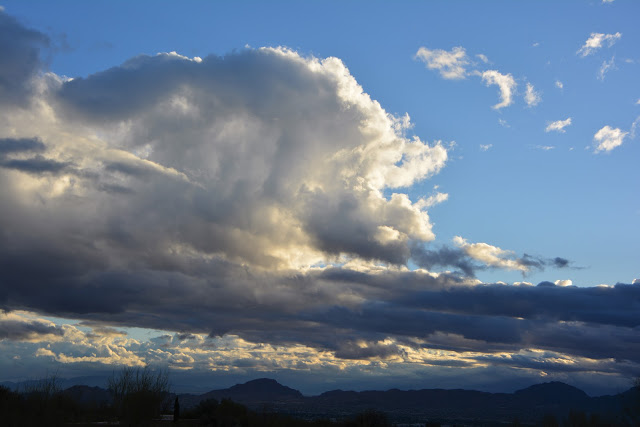I picked up my latest issue of Sunset magazine and read this article about the Sky Islands we see every day from our home. I learned several things from the article... first that the Sky Island chain running from Arizona and New Mexico down into Sonora, Mexico is called the Madrean Archipelago and is among the largest grouping of sky islands on earth. Second is the biological diversity, in both plants and animals found in the Madrean Archipelago. So much to explore!
Where to Embark on a Sky Island Adventure
All mountains inspire daydreams, but none more powerfully than these
It’s
the most romantic name in the world for a mountain: sky island. The two words conjure up a magical, lofty kingdom from
Avatar or
your favorite children’s book, and though they’re surrounded by land
and not water, they possess all the island essentials. They are
separate. They follow their own rules. And they are hard to get to.
Rising from sparse grasslands or deserts,
sky islands aren’t hard to define. They’re isolated peaks, shooting up
out of the flatlands like the first stalks of corn in a summer garden.
And they rise in more than one corner of the American West: from
volcanic Mt. Rainier in Washington to Mt. Lassen in California to
Nevada’s Mt. Charleston, part of Spring Mountains National Recreation
Area. Perhaps the least-known natural wonders, these heights are
beautiful, unique, and life-sustaining for thousands of plants and
animals. Naturalist Weldon Heald coined the term in his 1967 book
Sky Island,
writing romantically about his beloved Chiracahua Mountains in Arizona.
The designation proved so poetically apt that it was later given to an
entire group of isolated ranges that extends from Arizona and New Mexico
deep into Sonora, Mexico. That broken chain—
55 mountains in all—is
called the Madrean Archipelago, and it’s among the largest grouping of
sky islands on earth.
Serving as bridges between the Rocky
Mountains and Mexico’s Sierra Madre, and between the Sonoran and
Chihuahuan deserts,
the Madreans are “one of the most biologically
diverse places in the contiguous United States,” says Louise Misztal,
executive director of the Sky Island Alliance, a Tucson-based
organization that works to protect and restore the biodiversity of the
region. “Half of the bird species in North America can be found here at
some point during the year. There are a dozen different species of
hummingbirds. And so many different bees.”
Part of the allure of a Southwestern sky island is the
element of surprise. As I drive across southern Arizona on I-10, they
loom in the distance, ridged and wrinkled, denim blue or
coffee
brown depending on the light, and seemingly not that distinct from the
desert around me. I pull off the interstate in Tucson and take the Sky
Island Scenic Byway (aka the Catalina Highway) toward Mt. Lemmon, the
highest point in the Santa Catalinas. At the base lies the
saguaro-and-brittlebush landscape of the Sonoran Desert. But as the
highway twists and climbs, the world transforms. It grows greener and
cooler, the saguaros replaced by cottonwoods and oaks, then, near the
summit, by stands of ponderosa pine. The 27 miles take me up 6,000 feet
through four distinct life zones—desert, grasslands, woodlands, and
forest. I may as well have driven from Mexico to Canada.
Once at Lemmon’s summit, I step out of
the car, pull on a fleece jacket, and gape. Spreading far below is what
looks to be the entire Southwest. Arizona is not short on scenic
wonders—there’s that big canyon in the state’s northwest corner, for
example. But no place has given me a greater sense of infinity.
Sky islands aren’t just for birds and gawking motorists.
Beyond the winged creatures that make homes here in the Madrean
Archipelago are four species of cat. Two are common: the mountain lion
and the bobcat. A third, the ocelot, is rare. The fourth, the jaguar, is
extremely scarce and serves as a potent symbol of the Madrean’s
ecological importance. Jaguars might call to mind images of tropical
rain forests, but the northern limit of their reach actually includes
parts of Arizona and New Mexico. They’ve long been considered endangered
in the United States. Now, to the excitement of wildlife biologists
like Sergio Avila of Sierra Club Outdoors—who has studied sky islands
for the past 15 years—they seem to be making a tentative comeback. “For
the last two decades, we’ve had at least one jaguar sighting in the
Madrean sky islands every year,” he says. “It’s where black bears and
jaguars meet. Nature is a series of collected elements. And the Sky
Islands are so rich because they have so many different elements.”
https://www.sunset.com/travel/outdoor-adventure/sky-island


















































